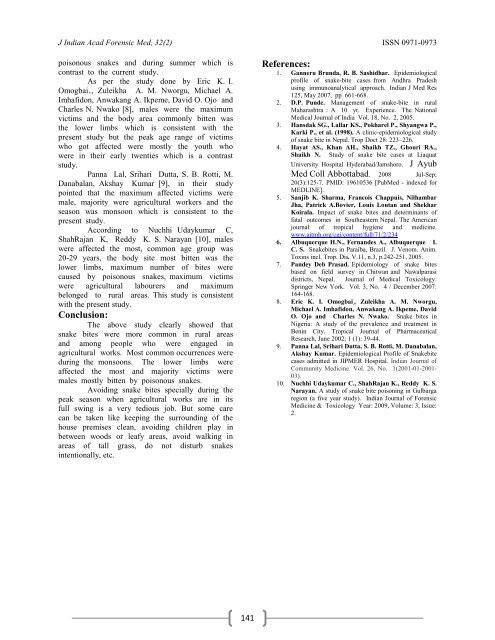jiafm, 2010-32(2) april-june. - forensic medicine
jiafm, 2010-32(2) april-june. - forensic medicine
jiafm, 2010-32(2) april-june. - forensic medicine
- No tags were found...
Create successful ePaper yourself
Turn your PDF publications into a flip-book with our unique Google optimized e-Paper software.
J Indian Acad Forensic Med, <strong>32</strong>(2) ISSN 0971-0973poisonous snakes and during summer which iscontrast to the current study.As per the study done by Eric K. I.Omogbai + , Zuleikha A. M. Nworgu, Michael A.Imhafidon, Anwakang A. Ikpeme, David O. Ojo andCharles N. Nwako [8], males were the maximumvictims and the body area commonly bitten wasthe lower limbs which is consistent with thepresent study but the peak age range of victimswho got affected were mostly the youth whowere in their early twenties which is a contraststudy.Panna Lal, Srihari Dutta, S. B. Rotti, M.Danabalan, Akshay Kumar [9], in their studypointed that the maximum affected victims weremale, majority were agricultural workers and theseason was monsoon which is consistent to thepresent study.According to Nuchhi Udaykumar C,ShahRajan K, Reddy K. S. Narayan [10], maleswere affected the most, common age group was20-29 years, the body site most bitten was thelower limbs, maximum number of bites werecaused by poisonous snakes, maximum victimswere agricultural labourers and maximumbelonged to rural areas. This study is consistentwith the present study.Conclusion:The above study clearly showed thatsnake bites were more common in rural areasand among people who were engaged inagricultural works. Most common occurrences wereduring the monsoons. The lower limbs wereaffected the most and majority victims weremales mostly bitten by poisonous snakes.Avoiding snake bites specially during thepeak season when agricultural works are in itsfull swing is a very tedious job. But some carecan be taken like keeping the surrounding of thehouse premises clean, avoiding children play inbetween woods or leafy areas, avoid walking inareas of tall grass, do not disturb snakesintentionally, etc.References:1. Ganneru Brunda, R. B. Sashidhar. Epidemiologicalprofile of snake-bite cases from Andhra Pradeshusing immunoanalytical approach. Indian J Med Res125, May 2007, pp 661-668.2. D.P. Punde. Management of snake-bite in ruralMaharashtra : A 10 yr. Experience. The NationalMedical Journal of India Vol. 18, No. 2, 2005.3. Hansdak SG., Lallar KS., Pokharel P., Shyangwa P.,Karki P., et al. (1998). A clinic-epidemiological studyof snake bite in Nepal. Trop Doct 28: 223–226.4. Hayat AS., Khan AH., Shaikh TZ., Ghouri RA.,Shaikh N. Study of snake bite cases at LiaquatUniversity Hospital Hyderabad/Jamshoro. J AyubMed Coll Abbottabad. 2008 Jul-Sep;20(3):125-7. PMID: 19610536 [PubMed - indexed forMEDLINE].5. Sanjib K. Sharma, Francois Chappuis, NilhambarJha, Patrick A.Bovier, Louis Loutan and ShekharKoirala. Impact of snake bites and determinants offatal outcomes in Southeastern Nepal. The Americanjournal of tropical hygiene and <strong>medicine</strong>.www.ajtmh.org/cgi/content/full/71/2/2346. Albuquerque H.N., Fernandes A., Albuquerque I.C. S. Snakebites in Paraíba, Brazil. J. Venom. Anim.Toxins incl. Trop. Dis. V.11, n.3, p.242-251, 2005.7. Pandey Deb Prasad. Epidemiology of snake bitesbased on field survey in Chitwan and Nawalparasidistricts, Nepal. Journal of Medical Toxicology.Springer New York. Vol. 3, No. 4 / December 2007:164-168.8. Eric K. I. Omogbai ., Zuleikha A. M. Nworgu,Michael A. Imhafidon, Anwakang A. Ikpeme, DavidO. Ojo and Charles N. Nwako. Snake bites inNigeria: A study of the prevalence and treatment inBenin City. Tropical Journal of PharmaceuticalResearch, June 2002; 1 (1): 39-44.9. Panna Lal, Srihari Dutta, S. B. Rotti, M. Danabalan,Akshay Kumar. Epidemiological Profile of Snakebitecases admitted in JIPMER Hospital. Indian Journal ofCommunity Medicine. Vol. 26, No. 1(2001-01-2001-03).10. Nuchhi Udaykumar C., ShahRajan K., Reddy K. S.Narayan. A study of snake bite poisoning in Gulbargaregion (a five year study). Indian Journal of ForensicMedicine & Toxicology Year: 2009, Volume: 3, Issue:2.141



![syllabus in forensic medicine for m.b.b.s. students in india [pdf]](https://img.yumpu.com/48405011/1/190x245/syllabus-in-forensic-medicine-for-mbbs-students-in-india-pdf.jpg?quality=85)



![SPOTTING IN FORENSIC MEDICINE [pdf]](https://img.yumpu.com/45856557/1/190x245/spotting-in-forensic-medicine-pdf.jpg?quality=85)

![JAFM-33-2, April-June, 2011 [PDF] - forensic medicine](https://img.yumpu.com/43461356/1/190x245/jafm-33-2-april-june-2011-pdf-forensic-medicine.jpg?quality=85)



![JIAFM-33-4, October-December, 2011 [PDF] - forensic medicine](https://img.yumpu.com/31013278/1/190x245/jiafm-33-4-october-december-2011-pdf-forensic-medicine.jpg?quality=85)


